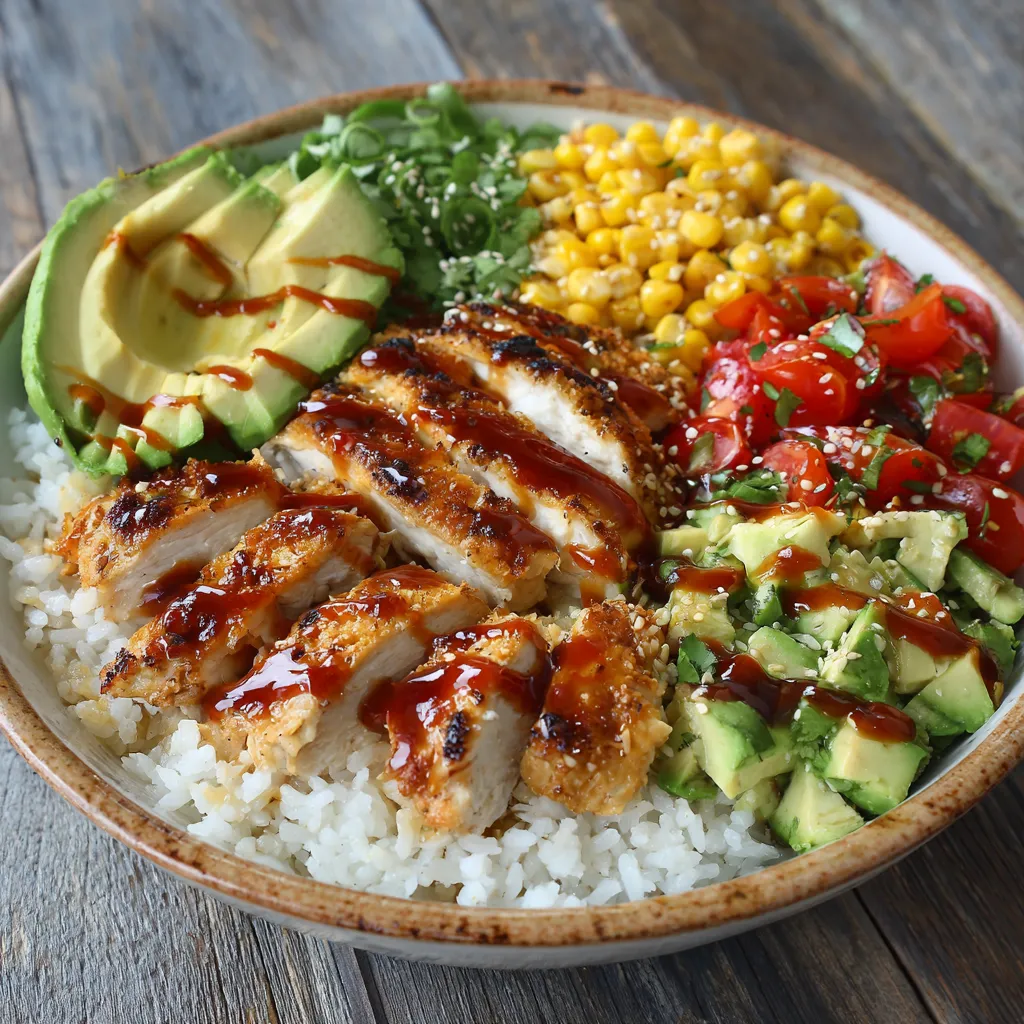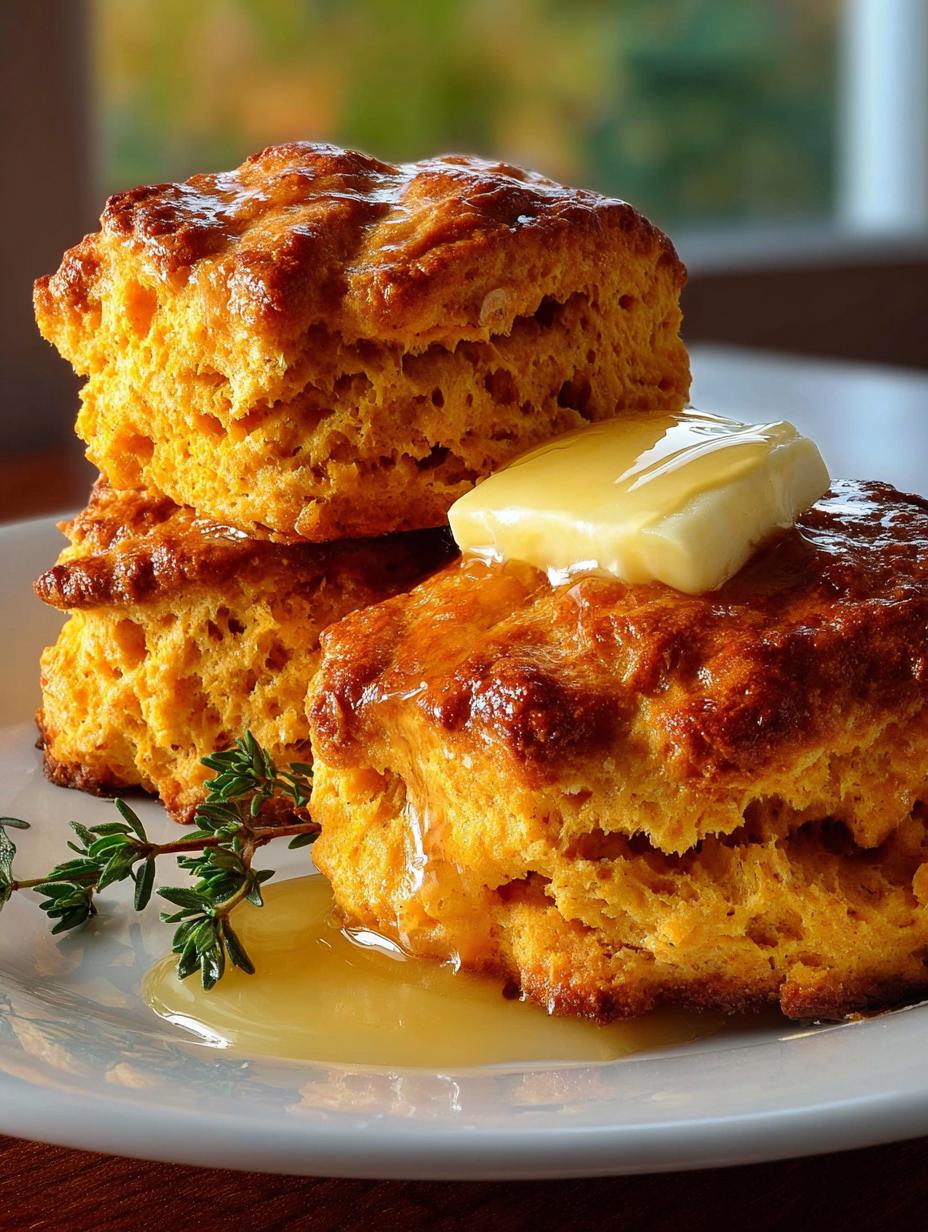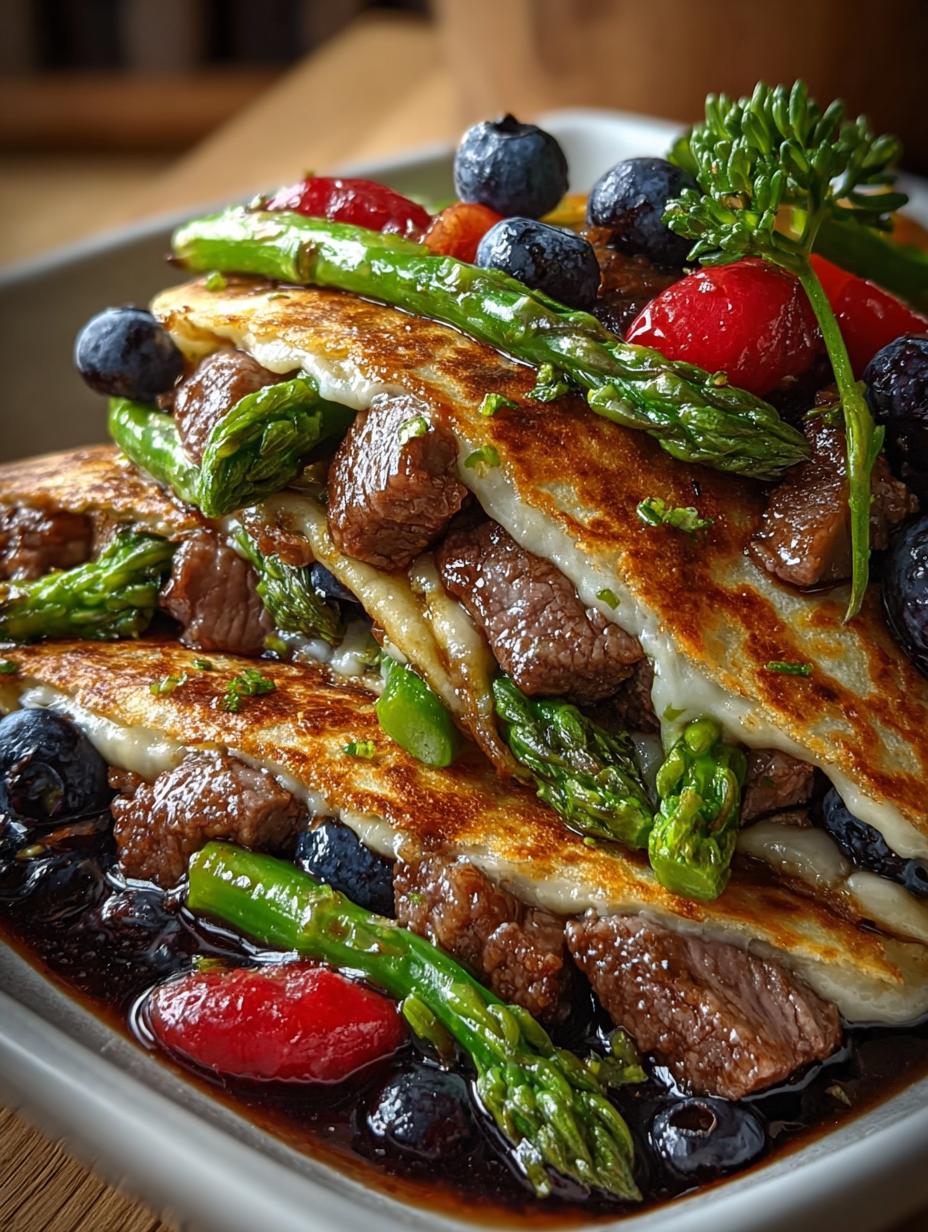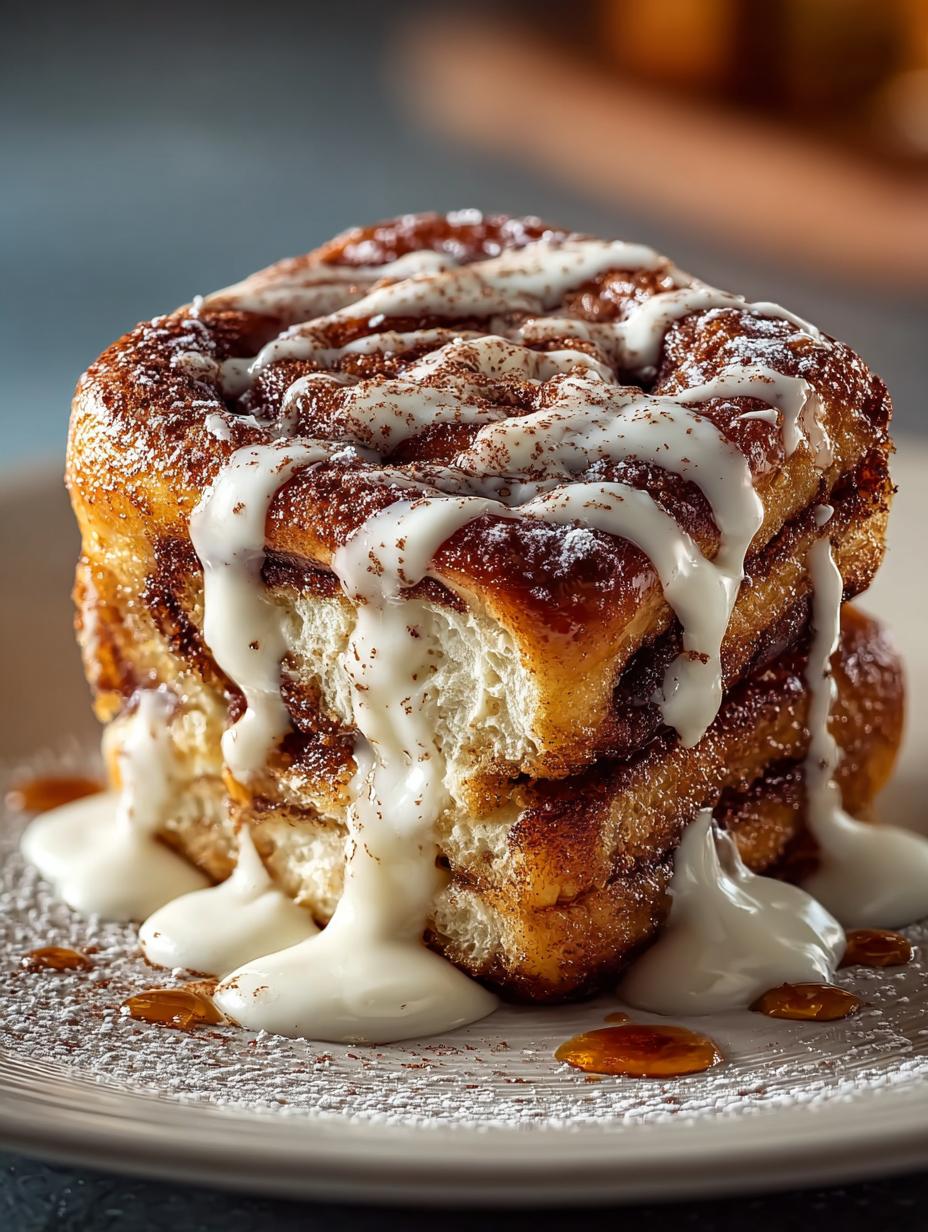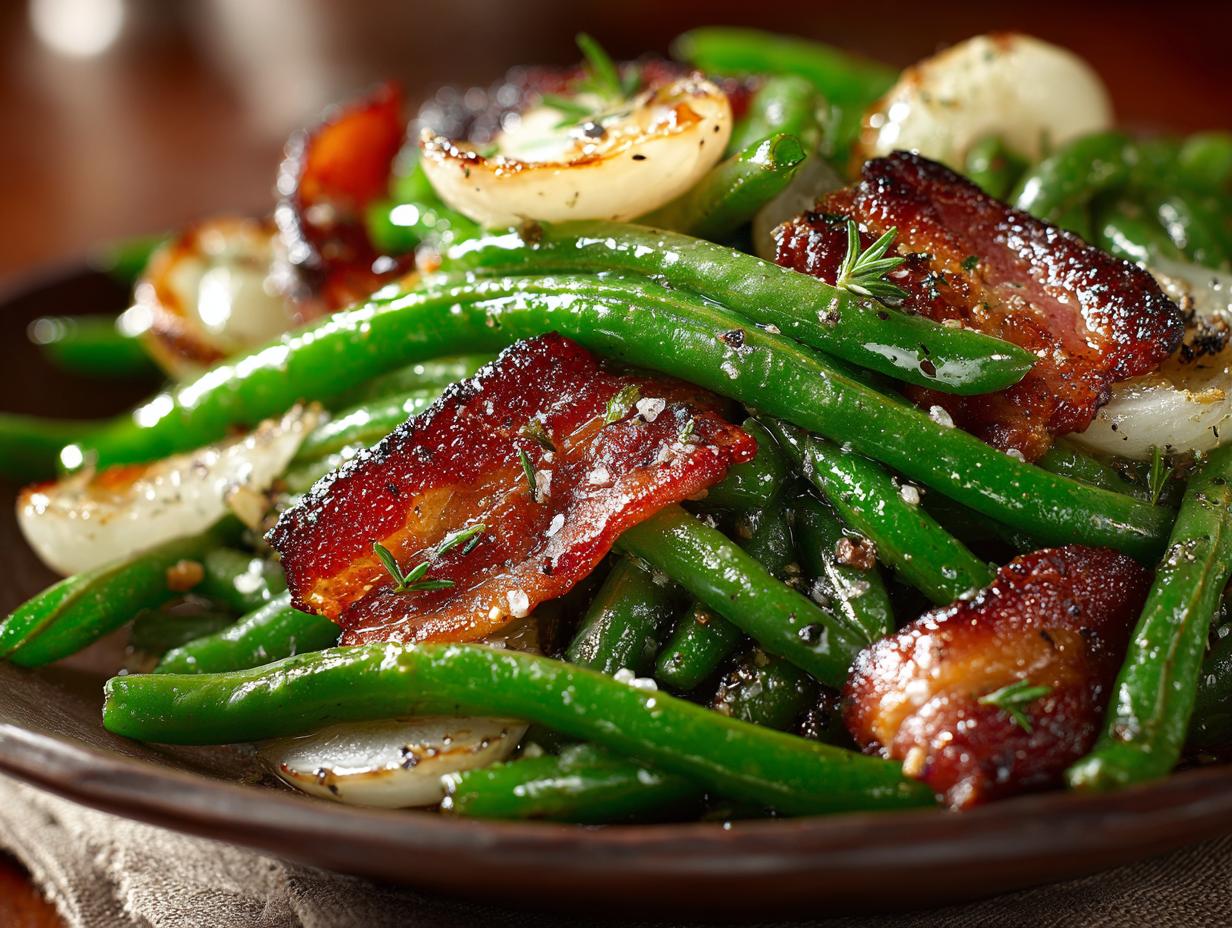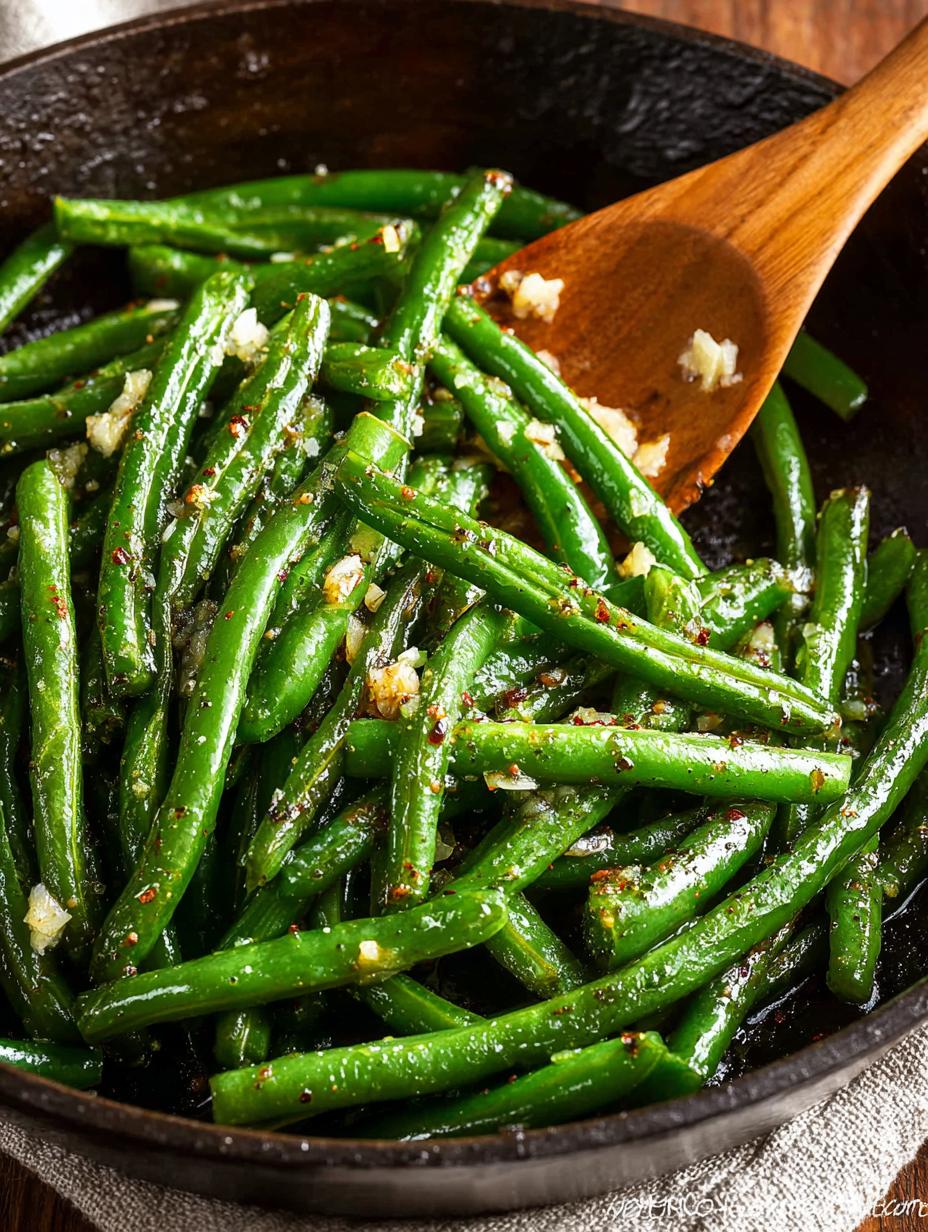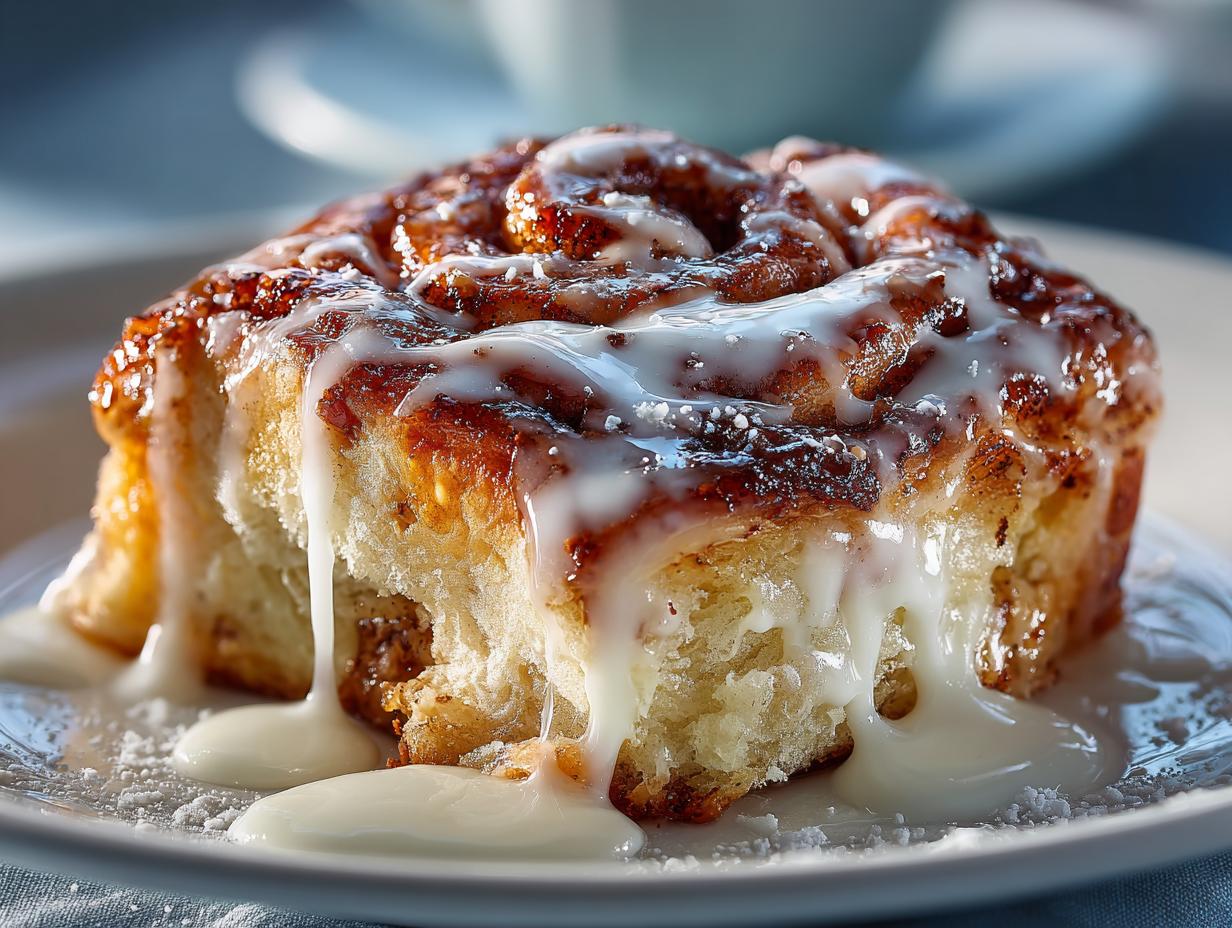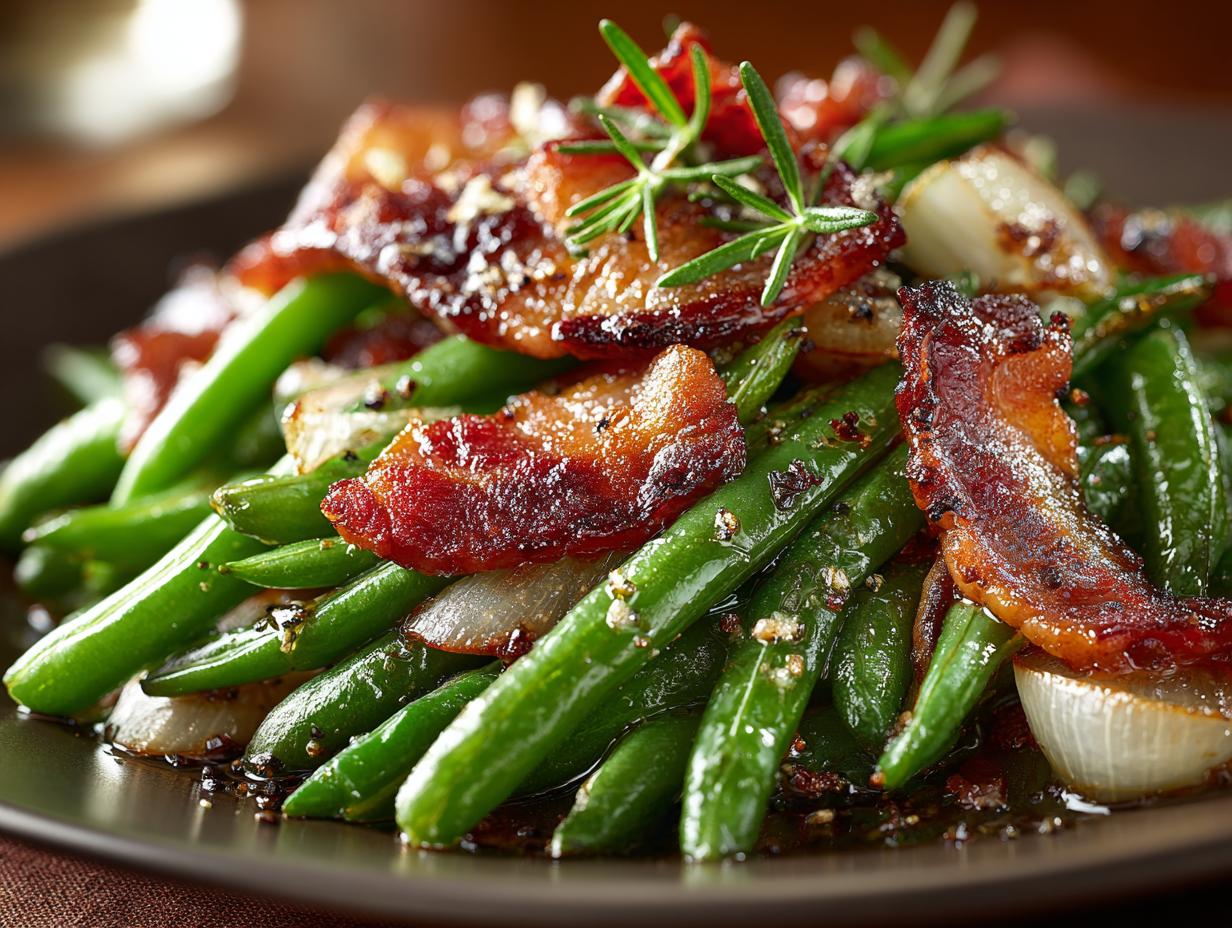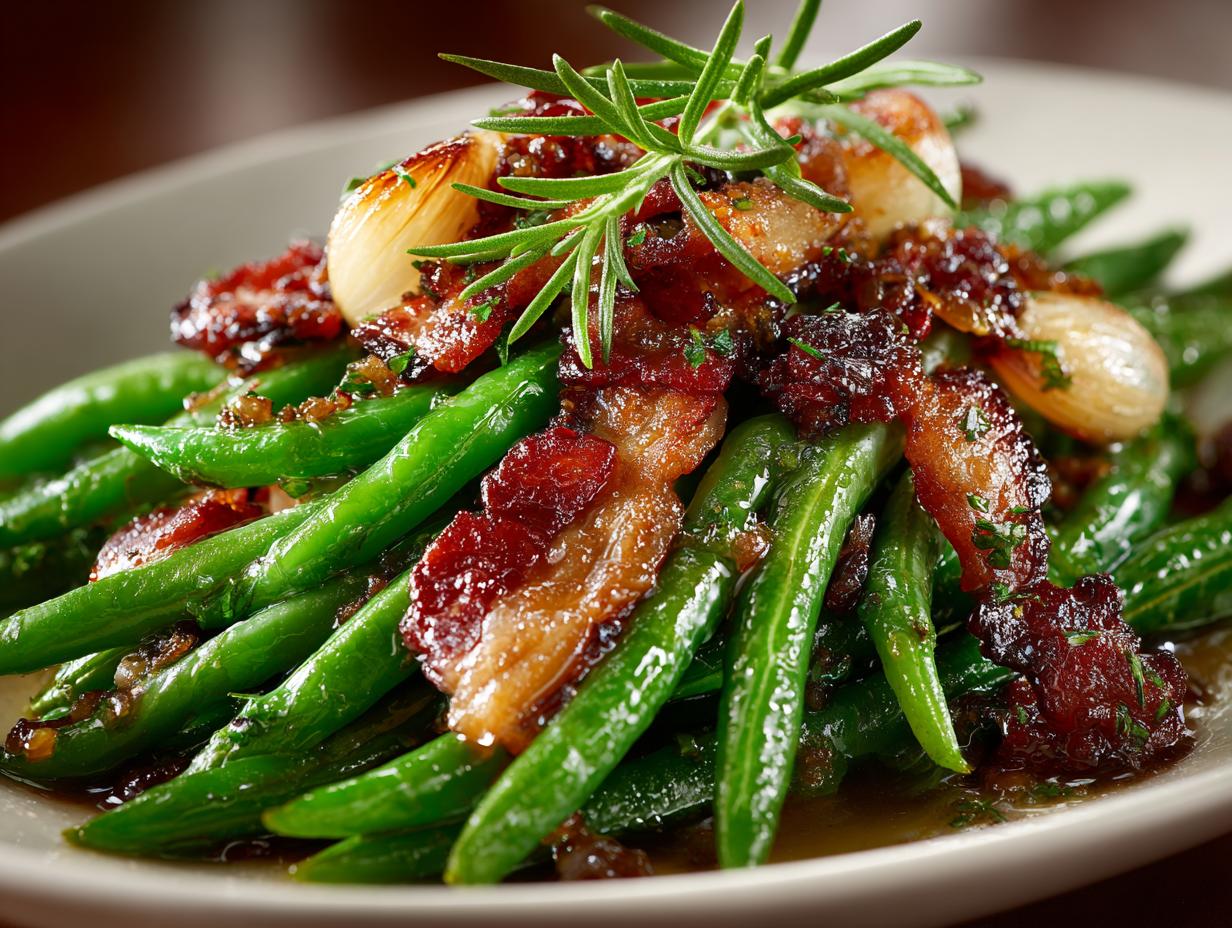Table of Contents
Looking for the perfect honey lime chicken bowls recipe? This easy, healthy meal comes together in just 30 minutes and is perfect for busy weeknights and meal prep!
There’s something magical about the moment when honey lime chicken bowls come together in your kitchen – the sweet caramelized glaze coating tender chicken, the bright pop of lime cutting through rich flavors, and the colorful array of fresh vegetables creating a rainbow in your bowl. This recipe has become my absolute go-to when I need something that’s both nourishing and satisfying, especially during those busy weeknight rushes when everyone’s hungry and I have exactly 30 minutes to make dinner magic happen.
I still remember the first time I discovered honey lime chicken bowls during a particularly hectic period in my life. I was juggling work deadlines, family obligations, and trying to maintain some semblance of healthy eating habits. Traditional meal prep felt overwhelming, and I was tired of the same old rotation of bland, “healthy” dinners that left everyone at the table less than excited about dinner time.
That’s when I stumbled upon this combination quite by accident. I had planned to make a simple grilled chicken dinner, but when I opened my pantry, I found myself with an abundance of honey, fresh limes from my weekly grocery haul, and a burning desire to create something that would make my family actually look forward to sitting down together. What started as a spontaneous marinade experiment turned into our most-requested family dinner – and the recipe that countless readers have told me saved their own weeknight dinner routines.
The beauty of honey lime chicken bowls lies in their perfect balance of flavors and incredible versatility. Whether you’re meal prepping for the week ahead, feeding a crowd of picky eaters, or simply craving restaurant-quality flavors without the restaurant price tag, this dish delivers on all fronts. The honey creates a gorgeous caramelized exterior on the chicken while keeping it incredibly juicy inside, while the lime adds that essential brightness that makes every bite feel fresh and vibrant.
Why You’ll Love These Honey Lime Chicken Bowls
When I first started making this recipe, I had no idea it would become such a game-changer for our family meals. These bowls have earned their place as a family favorite for so many reasons, and once you try them, you’ll understand why this recipe has been shared thousands of times across social media platforms.
First and foremost, they’re incredibly quick to prepare – from start to finish, you’ll have a complete, satisfying meal on the table in just 30 minutes. The marinade works its magic in as little as 15 minutes, though I highly recommend letting it sit for longer if you have the time.
Perfect for meal prep enthusiasts, these bowls store beautifully in the refrigerator for up to four days, making them ideal for Sunday meal prep sessions. The flavors actually improve over time as the ingredients meld together, which means your Wednesday lunch will taste even better than your Monday dinner.
Family-friendly doesn’t have to mean boring, and this recipe is proof of that philosophy. The honey provides a subtle sweetness that appeals to younger palates, while the lime and optional chili add complexity that keeps adults interested. I’ve served these to toddlers and grandparents alike, and everyone finds something to love. Even my pickiest eater asks for “the honey chicken bowls” specifically when planning our weekly menu.
Nutritionally, these bowls are powerhouses – packed with lean protein from the chicken, complex carbohydrates from rice or quinoa, healthy fats from avocado, and a rainbow of vegetables that provide essential vitamins and minerals. Each serving delivers approximately 35 grams of protein, making them perfect for active families and fitness enthusiasts.
The customization possibilities are endless. Prefer chicken thighs over breasts? Absolutely. Want to make it keto-friendly by skipping the rice? No problem. Need a dairy-free or gluten-free option? This recipe naturally accommodates both dietary restrictions without any complicated substitutions.
Ingredients for Honey Lime Chicken Bowls
Creating the perfect bowls starts with selecting quality ingredients. This recipe uses simple, fresh ingredients that work together to create complex, restaurant-quality flavors. What I love most about this ingredient list is that most items are probably already in your pantry and refrigerator.
For the honey lime chicken Marinade
- 3 tablespoons honey (preferably raw or local)
- ¼ cup fresh lime juice (about 2-3 large limes)
- 2 tablespoons lime zest (from the same limes used for juice)
- 3 cloves garlic, minced (or 1 tablespoon garlic powder)
- 2 tablespoons olive oil (extra virgin preferred)
- 1 tablespoon low-sodium soy sauce (or coconut aminos for gluten-free)
- 1 teaspoon ground cumin
- 1 teaspoon chili powder (adjust to taste preference)
- ½ teaspoon smoked paprika
- ½ teaspoon sea salt
- ¼ teaspoon black pepper
- ¼ teaspoon cayenne pepper (optional, for heat lovers)
For the Chicken and Vegetables
- 2 pounds boneless, skinless chicken thighs (or chicken breasts)
- 1 large red bell pepper, sliced
- 1 large yellow bell pepper, sliced
- 1 medium red onion, sliced
- 2 tablespoons olive oil (for cooking vegetables)
- Salt and pepper to taste
For the Bowl Assembly
- 3 cups cooked jasmine rice (or brown rice, quinoa, or cauliflower rice)
- 2 ripe avocados, sliced
- 1 cup cherry tomatoes, halved
- ½ cup fresh cilantro, chopped
- ⅓ cup red cabbage, thinly sliced (for crunch and color)
- ¼ cup red onion, finely diced (for garnish)
- Lime wedges for serving
- Optional: crumbled queso fresco or feta cheese
Ingredient Substitutions and Tips
Chicken Options: While I prefer boneless, skinless chicken thighs for their superior flavor and moisture retention, chicken breasts work perfectly well. If using breasts, consider pounding them to an even ¾-inch thickness to ensure uniform cooking. Chicken tenderloins are another excellent option that cooks even faster.
Sweetener Alternatives: If honey isn’t available, maple syrup or agave nectar make excellent substitutes. For a refined sugar-free option, try monk fruit sweetener or stevia, though you’ll need to adjust quantities as these are much sweeter than honey.
Citrus Variations: While lime is traditional and provides the signature flavor, lemon juice can be substituted in equal amounts. For a more complex citrus profile, try using half lime and half orange juice, which adds a subtle sweetness.
Spice Modifications: The spice blend is easily customizable. For a Mexican-inspired version, increase the cumin and add oregano. For an Asian twist, substitute the chili powder with Chinese five-spice and add fresh ginger to the marinade.
Vegetable Swaps: Bell peppers and onions are classics, but zucchini, broccoli, snap peas, or asparagus all work beautifully. Just adjust cooking times accordingly – more delicate vegetables like zucchini need only 5-7 minutes, while heartier options like broccoli may need 10-12 minutes.
How to Make Honey Lime Chicken Bowls (Step-by-Step)
Learning how to make this recipe is easier than you might think. The process breaks down into four simple steps that anyone can master, even on busy weeknights. Follow this tutorial, and you’ll have restaurant-quality results every single time.
Step 1: Prepare the Honey Lime Chicken Marinade
Creating the perfect marinade is the foundation of this recipe’s success. In a medium mixing bowl, whisk together the honey, fresh lime juice, and lime zest until the honey is completely dissolved. The key here is to use truly fresh lime juice – bottled lime juice lacks the bright, vibrant flavor that makes this dish special, so take the extra minute to juice fresh limes.
Add the minced garlic, olive oil, and soy sauce to the honey-lime mixture. The garlic will provide aromatic depth, while the olive oil helps carry flavors into the chicken and creates a better searing surface. Soy sauce might seem unexpected, but it adds umami depth and helps with browning.
Whisk in all the dry spices: cumin, chili powder, smoked paprika, salt, pepper, and cayenne (if using). The smoked paprika is particularly important as it adds a subtle smokiness that mimics grilled flavors even when cooking indoors. Whisk until the marinade is completely smooth and well combined.
Pro tip: Taste your marinade at this point. It should be bright, sweet, salty, and aromatic. If it’s too tart, add a bit more honey. If it needs more depth, add a pinch more salt. Remember, this marinade needs to flavor 2 pounds of chicken, so it should taste quite bold on its own.
Step 2: Marinate the Chicken
Pat the chicken thighs completely dry with paper towels – this is crucial for proper marinade absorption and eventual browning. If you’re using chicken breasts, consider cutting them into uniform pieces or pounding them to an even thickness for consistent cooking.
Place the chicken in a large zip-top bag or shallow dish and pour the marinade over it, ensuring every piece is well coated. Massage the marinade into the chicken, working it into any crevices or folds. This hands-on approach ensures maximum flavor penetration.
For best results, marinate for at least 30 minutes at room temperature, or up to 8 hours in the refrigerator. If marinating for longer than 2 hours, definitely refrigerate the chicken. The acids in the lime juice will begin to “cook” the chicken if left too long at room temperature, and extended marinating in the refrigerator actually improves the flavor and tenderness.
Time-saving tip: This recipe is perfect for meal prep. Marinate the chicken in the morning before work, and it’ll be perfectly flavored and ready to cook when you get home. You can even marinate it the night before for maximum flavor development.
Step 3: Cook the Chicken and Vegetables
Remove the chicken from the marinade and let excess drip off, but don’t worry about patting it completely dry – those marinade remnants will create a beautiful glaze as the chicken cooks. Reserve about ¼ cup of the marinade for basting during cooking.
Heat a large skillet or cast-iron pan over medium-high heat. Add a tablespoon of olive oil and let it shimmer but not smoke. Carefully place the chicken pieces in the pan, ensuring they’re not overcrowded. Overcrowding leads to steaming rather than searing, which prevents that gorgeous caramelization we’re after.
Cook the chicken for 6-8 minutes on the first side without moving it. This patience is rewarded with a beautiful golden-brown crust with slightly charred edges. The sugars in the honey will caramelize, creating complex flavors and an appetizing color. Flip the chicken and cook for another 5-7 minutes, basting occasionally with the reserved marinade.
Temperature check: Chicken thighs should reach an internal temperature of 165°F (74°C), while breasts should be removed at 160°F (71°C) as they’ll continue cooking from residual heat. Use a meat thermometer for accuracy – overcooked chicken is the enemy of juicy, flavorful results.
While the chicken rests (a crucial 5-minute step that allows juices to redistribute), cook your vegetables in the same pan to capture all those flavorful browned bits. Add the sliced bell peppers and onions with a drizzle of olive oil, seasoning with salt and pepper. Cook for 8-10 minutes until they’re tender-crisp with slight char marks.
Step 4: Assemble Your Bowls
Proper assembly makes the difference between a thrown-together meal and a restaurant-worthy presentation. Start with a base of warm, fluffy rice in each bowl – about ¾ cup per serving. The rice serves as both a flavor absorber and a textural contrast to the tender chicken.
Slice the rested chicken against the grain into strips about ½-inch thick. This cutting technique ensures maximum tenderness by shortening the muscle fibers. Arrange the chicken over one section of the rice, allowing the beautiful caramelized edges to show.
Add the cooked bell peppers and onions to another section of the bowl, creating visual interest with the colorful vegetables. The slight char and tender-crisp texture provide important contrasts to the soft rice and tender chicken.
Fresh element assembly: This is where the bowl truly comes alive. Add sliced avocado, halved cherry tomatoes, and thinly sliced red cabbage in separate sections. The avocado provides creamy richness, tomatoes add fresh acidity, and cabbage contributes essential crunch.
Finish with a generous sprinkle of fresh cilantro, a few pieces of finely diced red onion for sharp flavor bursts, and lime wedges for individual customization. If using cheese, crumble queso fresco or feta over the top just before serving.
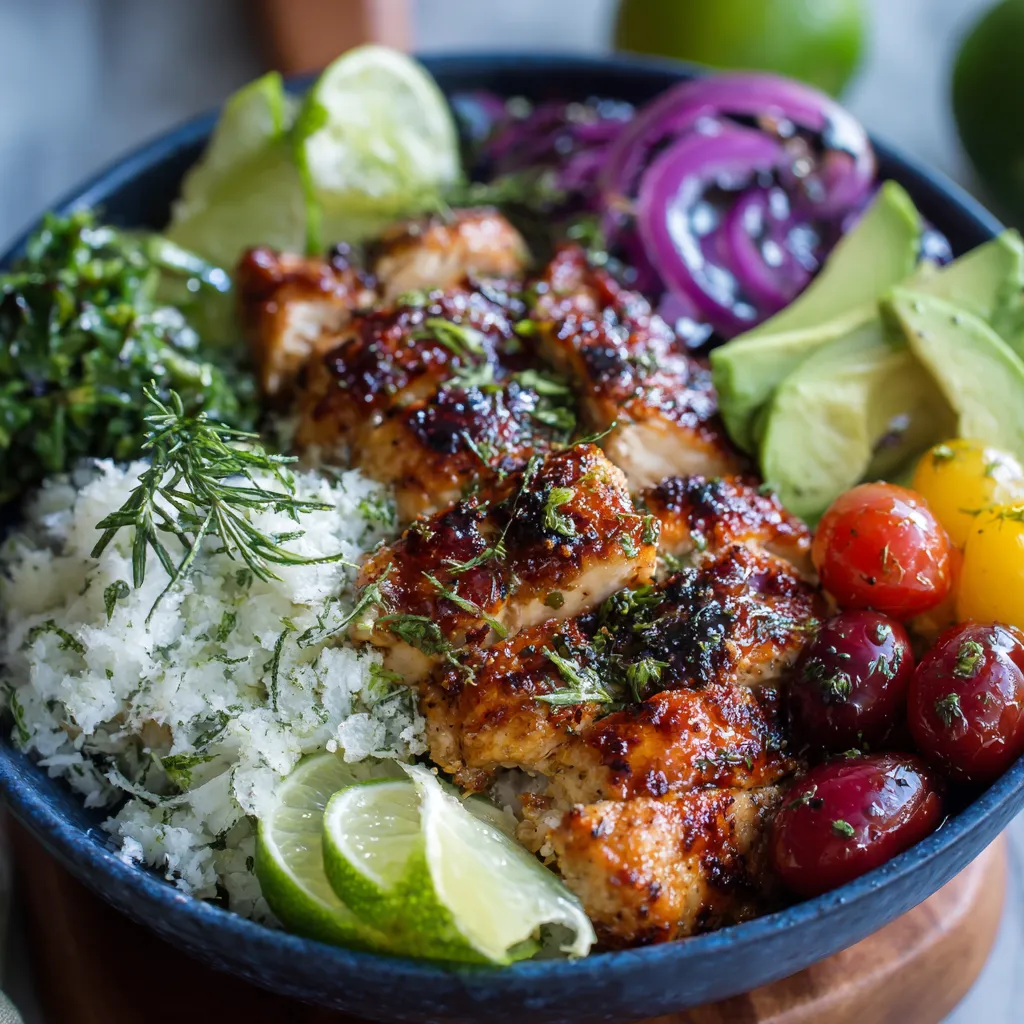
Meal Prep Instructions for Honey Lime Chicken Bowls
One of the biggest advantages of this recipe is how well it works for meal preparation. These bowls are meal prep champions, maintaining their delicious flavors and textures for days when stored properly. The key to successful meal prep lies in understanding which components store well together and which are better added fresh.
Storage Guidelines
Complete assembled bowls can be stored in airtight containers in the refrigerator for up to 4 days. Use glass containers when possible, as they don’t absorb odors and heat more evenly when reheating. Portion everything except avocado and fresh lime juice, which are better added fresh to maintain optimal texture and prevent browning.
Component storage offers more flexibility and fresher results. Store cooked chicken, rice, and roasted vegetables in separate airtight containers. This method allows you to mix and match components throughout the week and ensures each element maintains its ideal texture.
The cooked chicken actually improves in flavor over the first 2-3 days as the spices continue to meld. Store it in its own container, and don’t slice it until you’re ready to serve – whole pieces retain moisture better than sliced chicken.
Fresh components like avocado, cilantro, and lime wedges should be prepped but stored separately. Cut avocados just before serving, or if you must prep them ahead, toss with lime juice and store in an airtight container for maximum 2 days.
Reheating Tips
Microwave method: Remove any fresh garnishes, cover the bowl with a damp paper towel, and heat in 30-second intervals until warmed through. The damp paper towel prevents the rice from drying out and helps create steam for even heating.
Stovetop method: For best results, reheat components separately. Warm the chicken in a covered skillet with a tablespoon of water or chicken broth to prevent drying. Heat rice in a covered saucepan with a splash of water, stirring occasionally.
Oven method: Preheat to 350°F (175°C), cover the bowl with foil, and heat for 10-15 minutes until warmed through. This method is ideal when reheating multiple portions simultaneously.
Make-Ahead Components
Marinade can be prepared up to one week in advance and stored in the refrigerator. In fact, allowing the spices to meld actually improves the flavor. Mix in fresh lime juice just before using for the brightest flavor.
Rice preparation: Cook a large batch of rice on Sunday and store it in the refrigerator for the entire week. Properly stored rice maintains good texture for up to 6 days. Add a tablespoon of water when reheating to restore moisture.
Vegetable prep: Bell peppers and onions can be sliced up to 3 days in advance. Store them in separate airtight containers in the refrigerator. Cherry tomatoes can be halved and stored for up to 2 days.
Serving Suggestions and Variations
The versatility of this recipe means you can adapt it to suit any taste preference or dietary need. These variations have helped me keep this recipe exciting for my family, even when we eat it weekly.
Healthy Bowl Add-ins
Transform your basic bowls into nutritional powerhouses with strategic additions. Black beans or pinto beans add fiber and plant-based protein, making the bowl more filling and nutritionally complete. Rinse canned beans to reduce sodium, or cook dried beans in large batches for meal prep.
Roasted sweet potatoes provide complex carbohydrates, beta-carotene, and natural sweetness that complements the honey lime flavors beautifully. Dice and roast them with olive oil and a pinch of cumin for 25-30 minutes until tender and slightly caramelized.
Fresh or grilled corn adds sweetness and crunch, especially delicious during summer months. For year-round convenience, frozen corn works perfectly – just thaw and add directly to bowls, or quickly sauté for extra flavor.
Pickled red onions provide acidic brightness that cuts through the rich chicken. Quick-pickle thin onion slices in lime juice, vinegar, and a pinch of sugar for 15 minutes before serving.
Sauce and Dressing Options
While these bowls are delicious on their own, additional sauces can customize flavors for different preferences. Cilantro lime crema made with Greek yogurt, lime juice, cilantro, and garlic adds cooling richness that balances the honey’s sweetness.
Spicy chipotle sauce appeals to heat lovers – blend chipotle peppers in adobo with mayo or Greek yogurt, lime juice, and honey for a smoky, spicy condiment that perfectly complements the existing flavors.
Avocado lime dressing doubles down on the fresh flavors while adding healthy fats. Blend avocado, lime juice, cilantro, olive oil, and a touch of honey until smooth. This dairy-free option works perfectly for various dietary needs.
Mango salsa introduces tropical flavors that pair beautifully with the honey lime combination. Dice fresh mango, red onion, jalapeño, and cilantro, then toss with lime juice and a pinch of salt.
Low-Carb and Keto Modifications
Cauliflower rice makes an excellent low-carb substitute for traditional rice, reducing the carb content by about 80% while maintaining the bowl concept. Sauté riced cauliflower with garlic and lime juice for extra flavor, or use frozen cauliflower rice for convenience.
Zucchini noodles offer another spiralized vegetable base that absorbs the flavors beautifully. Quickly sauté spiralized zucchini for 2-3 minutes to maintain texture while warming through.
Double the vegetables instead of using any grain base. Roasted broccoli, asparagus, Brussels sprouts, and bell peppers create a rainbow of colors and nutrients while keeping carbs minimal.
Lettuce wraps transform the bowl into hand-held portions. Use butter lettuce leaves as cups, filling each with chicken, vegetables, and garnishes for a fun, interactive meal that’s perfect for parties.
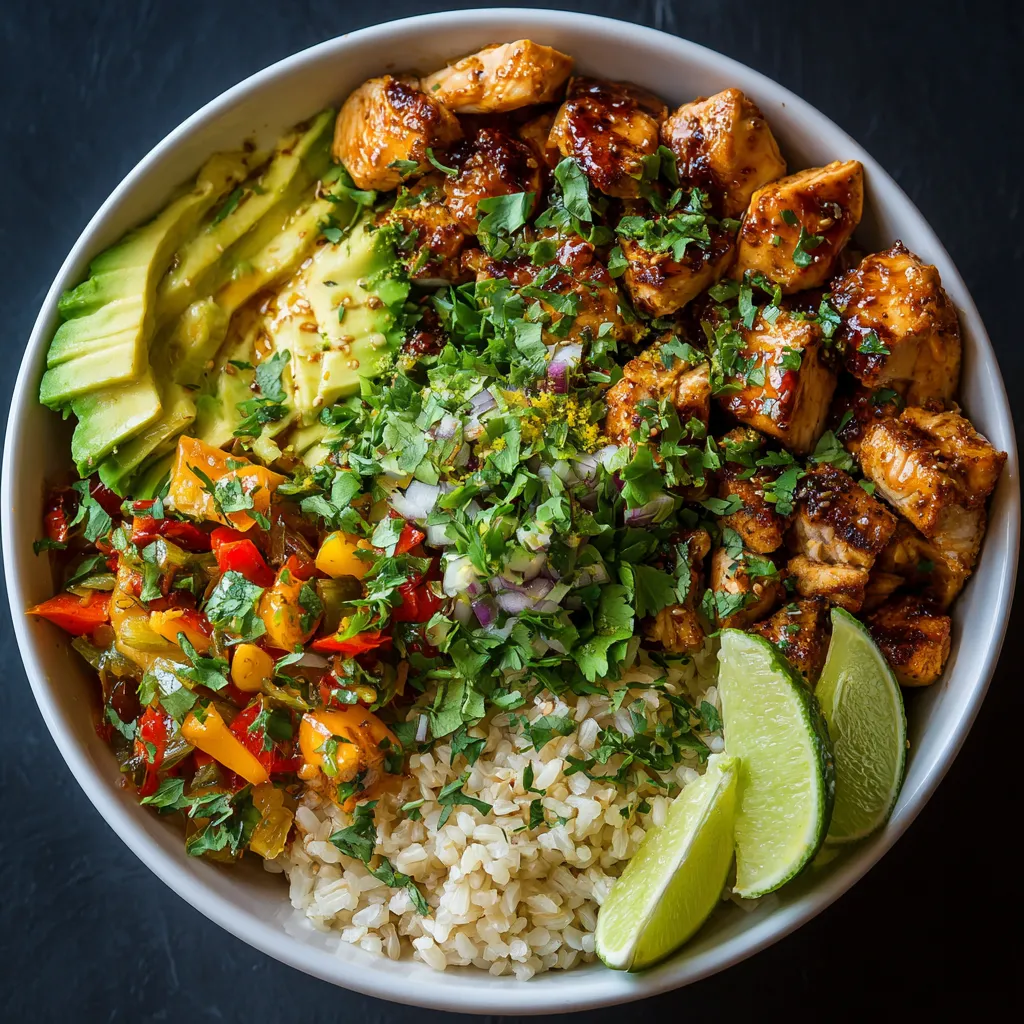
Nutritional Information and Health Benefits
Macro Breakdown per Serving
Each serving provides a well-balanced macronutrient profile that supports various health and fitness goals. Based on the recipe as written (serving 4 people), each bowl contains approximately:
Calories: 520-580 (depending on rice portion and avocado amount) Protein: 35-40 grams from chicken thighs, with additional protein from rice Carbohydrates: 45-55 grams, primarily from rice and vegetables Fat: 18-25 grams from olive oil, avocado, and chicken skin Fiber: 8-12 grams from vegetables, rice, and avocado Sugar: 12-15 grams, primarily from honey and natural vegetable sugars
Protein and Fiber Content
The high protein content makes these bowls excellent for muscle maintenance and growth, appetite control, and metabolic support. Chicken thighs provide complete protein containing all essential amino acids, while the combination of rice and beans (if added) creates additional complete protein profiles.
Fiber benefits extend beyond digestive health. The soluble fiber in avocados helps regulate cholesterol levels, while insoluble fiber from vegetables promotes healthy gut bacteria and sustained energy levels. The combination of fiber sources helps slow sugar absorption, preventing blood sugar spikes despite the honey content.
Micronutrient density is impressive – bell peppers provide vitamin C, tomatoes offer lycopene, avocados supply potassium and healthy monounsaturated fats, and cilantro contributes vitamin K and antioxidants. The colorful vegetable array ensures a wide spectrum of phytonutrients.
Dietary Considerations
This recipe naturally accommodates many dietary preferences and restrictions with minimal modifications. Gluten-free diets are easily supported by substituting coconut aminos for soy sauce and ensuring rice rather than wheat-based grains.
Dairy-free requirements are met in the base recipe, with optional cheese being the only dairy component. Plant-based alternatives like nutritional yeast can provide similar umami flavors if desired.
Lower sodium versions can be created by reducing or eliminating soy sauce, using low-sodium alternatives, and relying more heavily on citrus, herbs, and spices for flavor development.
Anti-inflammatory benefits come from turmeric (if added to the spice blend), garlic, ginger, and the variety of colorful vegetables. Lime juice provides vitamin C, which supports immune function and collagen production.
Pro Tips for Perfect Results
Marinating Secrets
Temperature control affects marinating effectiveness significantly. Room temperature marinating for 30-60 minutes allows enzymes to work more effectively than refrigerated marinating, but longer periods require refrigeration for food safety. For optimal results, marinate at room temperature for 1 hour, then refrigerate for additional time.
Acid balance is crucial in marinades. While lime juice tenderizes protein, too much acid for too long can actually “cook” the chicken, creating a mushy texture. The ratio in this recipe is carefully balanced for optimal flavor and texture development.
Marinade penetration improves with surface area exposure. Score thick pieces of chicken lightly with shallow cuts, or use a meat mallet to create small indentations without flattening the meat. This technique allows marinade to penetrate deeper into the protein.
Double-duty marinades work efficiently when you reserve a portion for basting during cooking. However, never reuse marinade that has been in contact with raw chicken without boiling it first to eliminate any harmful bacteria.
Cooking Techniques
Proper searing requires patience and the right temperature. Medium-high heat creates the Maillard reaction that develops complex flavors and appealing color, while too-high heat burns the honey before the chicken cooks through. Listen for steady sizzling – violent spattering indicates heat is too high.
Even cooking is achieved through uniform piece sizes and not overcrowding the pan. Cook in batches if necessary, keeping finished pieces warm in a low oven while completing the remaining chicken.
Carryover cooking continues after removing chicken from heat. Chicken thighs should reach 165°F internal temperature, but removing them at 160°F and allowing 5 minutes of rest time utilizes carryover cooking to reach the safe temperature without overcooking.
Pan sauce creation takes advantage of the flavorful brown bits left in the cooking pan. After removing chicken, deglaze with a splash of lime juice or chicken broth, scraping up browned bits to create an additional sauce for drizzling.
Flavor Enhancement Tips
Layered seasoning builds more complex flavors than single-step seasoning. Season the chicken with salt and pepper before marinating, allowing these base seasonings to penetrate while the marinade works on surface flavors.
Fresh herb timing matters for optimal impact. Add hardy herbs like thyme to marinades, but save delicate herbs like cilantro for garnishing just before serving to maintain their bright, fresh flavors and appealing color.
Citrus zest amplification provides more lime flavor than juice alone. The oils in citrus zest are more potent and heat-stable than juice acids, so they maintain their impact throughout cooking and storage.
Umami boosters can elevate the overall flavor profile without changing the recipe’s character. A small amount of fish sauce, worcestershire sauce, or tomato paste in the marinade adds depth without identifiable fishy or tomato flavors.
Frequently Asked Questions
Can I use chicken breasts instead of thighs?
Absolutely! Chicken breasts work perfectly in this recipe, though they require slight adjustments for optimal results. Because breasts are leaner than thighs, they can dry out more easily, so reduce cooking time slightly and monitor internal temperature carefully. Remove breasts from heat when they reach 160°F internal temperature, as carryover cooking will bring them to the safe 165°F.
For best results with chicken breasts, pound them to an even ¾-inch thickness or butterfly thick breasts to ensure uniform cooking. The marinade time can be reduced to 20-30 minutes for breasts since their texture is more delicate than thighs.
Consider cutting larger breasts into smaller, uniform pieces before marinating and cooking. This approach ensures even flavor distribution and reduces cooking time, making it perfect for quick weeknight dinners.
How long can I store these bowls?
Properly stored bowls maintain their quality and safety for up to 4 days in the refrigerator. Store complete bowls in airtight containers, though you’ll achieve better results by storing components separately when possible.
For longer storage, cooked chicken can be frozen for up to 3 months. Freeze it in meal-sized portions with a bit of the cooking liquid to prevent freezer burn. Rice freezes well too, though the texture changes slightly – frozen rice works better for fried rice applications than as a fresh bowl base.
Fresh components like avocado and cilantro should always be added just before serving, even for short-term storage. Cut avocados can be stored for up to 2 days when tossed with lime juice and kept in airtight containers.
Never leave assembled bowls at room temperature for more than 2 hours, or 1 hour when ambient temperature exceeds 90°F. These time limits ensure food safety and prevent bacterial growth.
What’s the best rice for chicken bowls?
Jasmine rice is my top choice due to its slightly sticky texture that holds together well in bowl format and its subtle floral aroma that complements the honey lime flavors without competing.
Brown rice provides more fiber and nutrients while adding a nuttier flavor and chewier texture. It requires longer cooking time but offers superior nutritional value and stays firmer during storage and reheating.
Basmati rice works beautifully with its long grains and distinct aroma, particularly if you want to emphasize the exotic flavor profile of the dish. Its fluffy texture provides nice contrast to the tender chicken.
Short-grain rice varieties like sushi rice or Arborio create creamier, more cohesive bowl bases that some people prefer. These rice types absorb flavors particularly well, making them excellent choices when you want the rice to take on the honey lime essence.
For meal prep purposes, jasmine and basmati rice maintain their texture better than brown rice during refrigerated storage, while brown rice provides better nutritional value for health-conscious diners.
Can I make this dairy-free/gluten-free?
This recipe is naturally dairy-free in its base form – the only dairy component is optional cheese for garnishing. Simply omit the cheese or substitute with dairy-free alternatives like nutritional yeast for umami flavor, or cashew cream for richness.
Gluten-free adaptation requires only one substitution: replace soy sauce with coconut aminos or gluten-free tamari. These alternatives provide the same umami depth and salty flavor that soy sauce contributes to the marinade.
All other ingredients are naturally gluten-free, including rice, vegetables, and all spices used in the marinade. Always check spice blend labels if using pre-mixed seasonings, as some contain anti-caking agents derived from wheat.
Cross-contamination prevention is important for those with celiac disease. Use dedicated cutting boards and utensils, and ensure your rice and spices haven’t been processed in facilities that also handle wheat products.
For additional richness without dairy, try adding sliced avocado, tahini-based dressings, or coconut cream-based sauces that complement the existing flavor profile while maintaining the dairy-free nature of the dish.
More Easy Chicken Bowl Recipes
Once you’ve mastered honey lime chicken bowls, you’ll probably want to explore other flavor combinations using the same successful formula. The beauty of bowl meals lies in their adaptability – you can swap marinades, vegetables, and garnishes while maintaining the same cooking techniques and meal prep advantages.
Consider trying Mediterranean chicken bowls with lemon-herb marinated chicken, cucumber tomato salad, olives, and tzatziki sauce over quinoa. The same basic preparation method works perfectly with different flavor profiles.
Asian-inspired chicken bowls using soy-ginger marinades, stir-fried vegetables, and sesame-lime dressing provide another delicious variation. Add edamame, shredded carrots, and sriracha for authentic flavors.
Mexican-style chicken bowls with cumin-chili marinades, black beans, corn salsa, and avocado crema offer familiar comfort food flavors in a healthy, customizable format.
The techniques you’ve learned here – proper marinating, temperature control, component storage, and flavor layering – apply to countless other bowl combinations. Once you understand these fundamentals, you can create endless variations based on seasonal ingredients, dietary preferences, and family favorites.
These honey lime chicken bowls represent everything I love about home cooking: they’re approachable enough for weeknight dinners, impressive enough for entertaining, healthy enough for daily eating, and delicious enough that everyone asks for the recipe. Whether you’re meal prepping for busy weeks ahead or creating a special family dinner, honey lime chicken bowls deliver on flavor, nutrition, and convenience in every single bowl.

